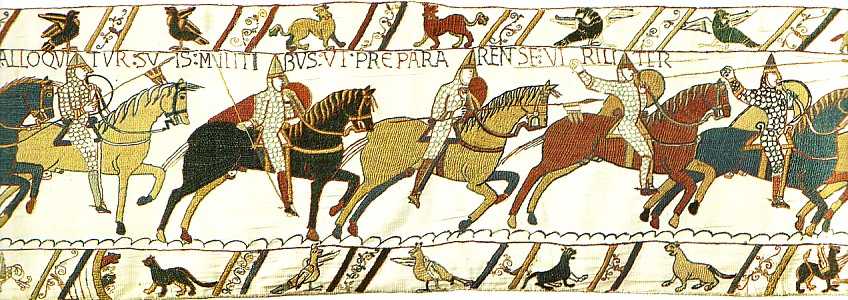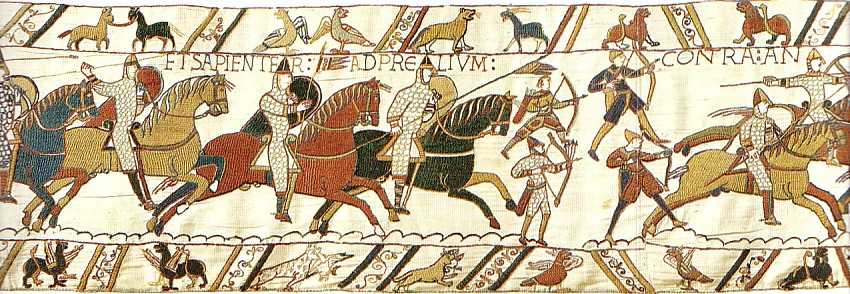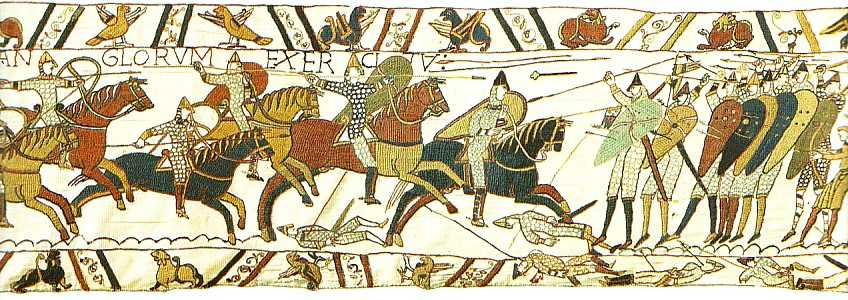

...EXHORTS HIS KNIGHTS TO PREPARE THEMSELVES BRAVELY...
The long column of knights ahead of William represents the first mounted attack. First we see knights riding with spears "at rest" or erect; now a group with their weapons poised to throw, led by two knights with gonfanons or pennons on their lances. Notice the apparent lack of visual sword belts: it has been determined that in the Tapestry 80% of all armored warriors have their sword belts under their mail. Reenactors who have tried this say that it is in fact more comfortable and keeps the sword stationary better than wearing a "convenient" sword belt outside the hauberk. Most of the knights in the Tapestry are wearing the standard mail hauberk which reaches to the elbow and knee. But two regular or rank-and-file knights are shown here with the more extensive - and expensive - armor which covers the limbs to wrist and ankle. The rearmost of the two is completely covered (cap-a-pie) as well as any great lords would be; while the fellow in front of him has mailed sleeves, and his armor reaches curiously down below the knee, which leads me to believe that the artisan started to stitch mailed legs on this leading figure too, then changed their mind.
"The Pregnant She-wolf" is shown in the lower border (again - it first appeared below the scene of Harold's voyage). Previous to this are a couple of very elaborate "dragons" facing each other; and in the border over William are a facing pair of pegasi. There seems to be significance in these opposite, paired and facing mythical animals: perhaps in the minds of the artisans there were parallels between the story of Bellerophon capturing Pegasus to fight the chimera and William's confrontation with Harold. William had the church behind him, and Harold was excommunicated: in short, a sort of Antichrist battling the champion of light and truth.
...AND WISELY FOR BATTLE AGAINST...
The marksmen opened the battle, and according to William of Poitiers no other infantry are mentioned. Those who "threw spears from a distance" are those last mentioned, and they are knights. Any heavy infantry involved must have been part of the first attack, and went in with the archers, crossbow-men and slingers. The armored archer is not an attempt to depict a crossbow-man, nor is he an officer, but rather a professional, and the other three in light clothing are representative of the rustics who were pressed into service. The fact that the professional archer is the only one of the four to be holding arrows in his bow hand for quick loading is further visual evidence of his higher skill. This little collection of bowmen could be held up as evidence that one-fourth of William's infantry were mailed.
All the forwardmost knights are aggressively poised, and each method of using the early lance is depicted: ready to thrust overarm (or throw), held for a forward swinging motion down low, and couched. The various changing groups of horsemen - from "at rest" to aggressive and now back to aggressive following the attack of the marksmen - indicates the separate attacks by the various divisions of the army, or else the succession of attack, withdrawal, and renewed attack.
In the upper border two animals (asses? dogs?) are tied together, perhaps signifying the helpless yoking together of William's and Harold's fates. And below are two more fables: "The Panther" and "The Cat and the Chickens" - Harold has stolen the crown. Another Aesop, "The Fox and the Billy-goat" is in the upper border.
...THE ENGLISH ARMY
As the Norman cavalry draw near, hand missiles fly from both sides: clearly depicted are two javelins passing each other in flight, and one "mace." (This is evidence to me that William of Poitiers had probably seen the Tapestry before he wrote his history of the Conqueror: for he mentions that the English threw sticks with stones lashed to their ends.) The Tapestry shows no fewer than fourteen javelins which have been thrown: nine embedded in shields or faces and five airborn. Since no horsemen are shown falling or pierced as yet, the dead in front of the English shield-wall must represent the earlier heavy infantry attack. The dead beneath the English are their own casualties; their shields are studded with arrows and one of the slain has an arrow in his mouth. The lone archer on the English side shows that there was a long range missile element in Harold's army, but such archers as he had were outnumbered at least four to one. The foremost housecarle is bearded and holds his battleaxe in the crook of his shield arm while he wields his spear. Many of these so-called housecarles are probably Danes, as Harold is said to have received strength from the land of the Danes. The bent-back formation of the English is apparent in the following picture: they fight facing both ways, to show that both flanks were under attack simultaneously, which agrees with both the Carmen and Poitiers. The staggered upwards posing of the left-facing English warriors is meant to depict their position on sloping ground.




